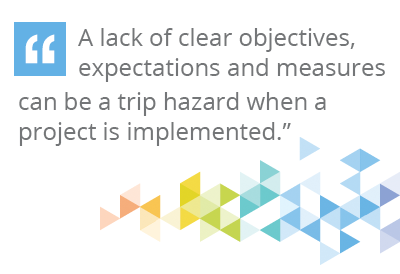Five Steps to Avoid Implementation Trip Hazards
- Follow these five steps to assure clear understanding of plans and objectives
- When planning change, organizations must consider several company-wide factors
- A structured approach to implementing change is crucial
It’s not unusual for team members to have a general knowledge of the key activities required to succeed in any given task, function or project (e.g. a demand creation program launch, a project to improve business processes). However, this often isn’t enough. A lack of clear objectives, expectations and measures can be a trip hazard when a project is implemented.
 Leading change may not be part of your job description, but it’s likely you are indeed leading some sort of change in your organization. Whether it is leading a demand creation program launch or the improvement of business processes, there are five key steps to assure a successful implementation. The following steps can provide structure, guidance and the means of tracking progress for many types of projects.
Leading change may not be part of your job description, but it’s likely you are indeed leading some sort of change in your organization. Whether it is leading a demand creation program launch or the improvement of business processes, there are five key steps to assure a successful implementation. The following steps can provide structure, guidance and the means of tracking progress for many types of projects.
- Illustrate what the final destination looks like, and share the vision across the organization. Identify and document what “good” (or even “great”) looks like and the signals that exemplify a successful implementation. To get a true sense of success, define it from a customer point of view (the people the business serves) and an internal view (the benefits to the business and the people executing towards the defined goals).
- Get to know the people you will encounter across the end-to-end journey. Reach outside the purview of the sponsoring organization to discover who will be impacted by the change or implementation. Identify the key stakeholders across the organization as well as potential points of acceptance, resistance, impact and leverage. Work to understand stakeholder issues, jointly overcome objections and identify opportunities to leverage resources toward success. Everyone comes to the table with a unique perspective, so be open to hearing new ways of getting things done. Document a high-level process that illustrates what is being done and who is currently responsible. In the wake of discovery, know who your champions are, and who in the organization you need to build relationships with to assure unfounded concerns won’t cause problems in the future.
- Define measures that are actionable and enable the business to adjust the plan to meet the success criteria. These measures should be multidimensional, meaning the metrics demonstrate a healthy process and performance. If you are launching a demand creation program, for example, measure the number of leads created as well as the number of leads converted to revenue. Looking at the number of leads alone is an indicator that you can drive interest, but the conversion rate to revenue (success rate) demonstrates whether you’ve hit the right target, used the tactics that meets the buyer where he or she gets information, and scripted the messaging that resonates with the buyer’s needs. If your conversion is low, there’s an opportunity to adjust to drive the desired results.
- Set clear expectations about how each part of the organization is contributing to the overarching vision and how it is measured. If you are launching a demand creation program, identify the team members involved from strategy definition, plan creation, asset construction, execution, enablement and performance tracking. Get everyone on board with the big picture and ensure they have the means to provide feedback. If you are engaging parts of the business that are operating as a service, ensure you have service-level agreements defined that manage expectations and accountability.
- Track performance across the entire journey. Establishing a baseline set of measures prior to kicking off an initiative is important to orienting the implementation. At first, new measures will only provide an indication of movement from the starting point, and it may be difficult to use the data to establish a need to change the plan. Over time, consistent measurement will turn into more predictive indicators of success. Any modifications to parts of the plan or process should provide results in the measurements collected.
Use these five steps to provide structure, guidance and the means of tracking the progress of your project or program implementation. Avoid the trip hazards by tying them up into a well-thought-out plan that’s been socialized to ensure that individuals know how they are contributing to the goals.
For more information, join us at the upcoming 2016 Summit in Nashville this May.